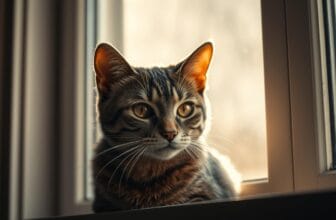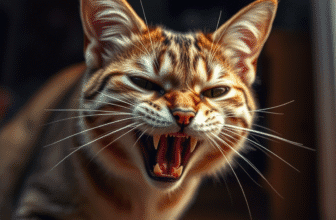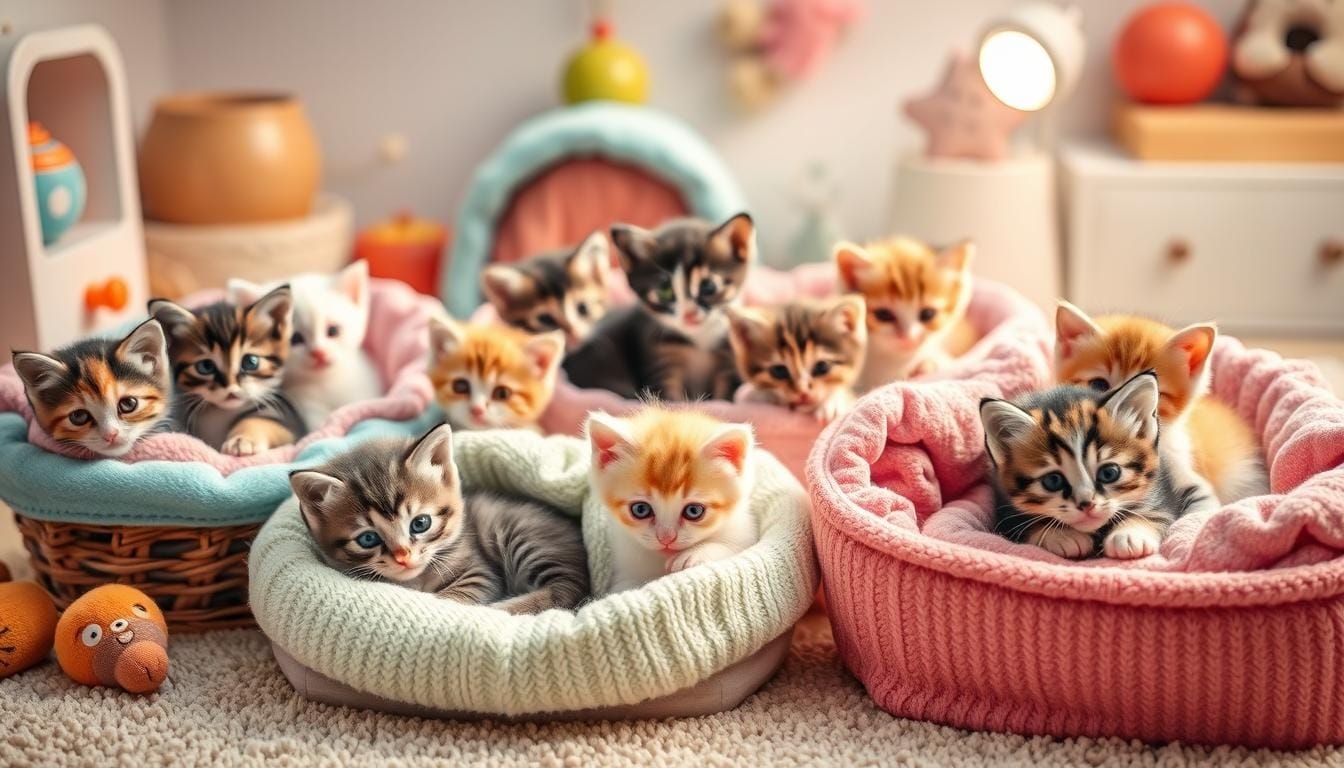
Table of Contents
When thinking about cat litter size and kitten care, knowing the basics of feline reproduction is key. How many kittens can cats have? Cats usually have four to six kittens in a litter, but this number can vary from one to nine kittens. This range is important for the health of the mother and her kittens.
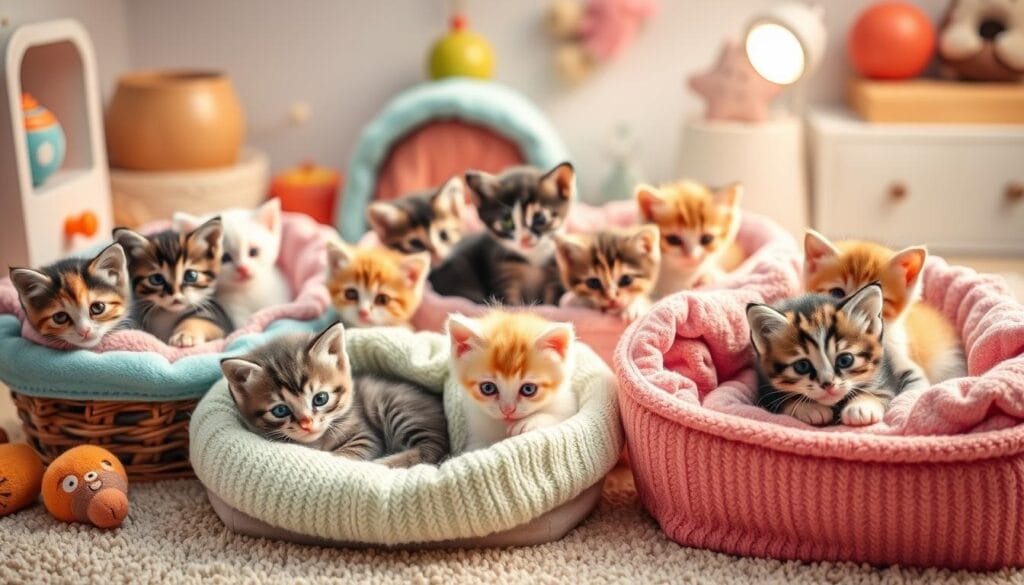
Cats can have up to 100 kittens in their lifetime if they’re not spayed or neutered. This number shows how crucial it is to be a responsible cat owner. By understanding what affects cat litter size, you can help your cat stay healthy. This also helps reduce the number of homeless cats in the US, which is about 1.4 million each year.
Understanding Cat Fertility and Reproduction
As a cat owner, knowing about cat fertility and reproduction is key. Cats can get pregnant as young as five months old. This leads to them having two to three litters a year on average.
Cats can breed all year round. Female cats can go into heat every 2-3 weeks. This can lead to a lot of litters if they’re not spayed or neutered. It’s important to understand the cat fertility cycle for responsible pet care and breeding.
Here are some key factors to consider when it comes to cat reproduction:
- Females can become pregnant at five months old
- Cats can have two to three litters per year
- The breeding season occurs throughout the year
- Female cats go into heat every 2-3 weeks
Knowing about cat reproduction helps you make better choices for your pet’s health. This knowledge is vital for giving your cat the best care and ensuring they live a happy, healthy life.
| Factor | Description |
|---|---|
| Reproductive Cycle | Complex cycle that allows females to become pregnant as early as five months old |
| Breeding Season | Occurs throughout the year, with females going into heat every 2-3 weeks |
| Cat Fertility | High due to the ability of females to become pregnant at a young age and have multiple litters per year |
How Many Kittens Can Cats Have in One Litter?
Cats usually have between four to six kittens in a litter. This number can change based on genetics, age, and health. A cat’s pregnancy lasts about two months, and they can have up to four litters a year.
Young cats, about one year old, often have three to four kittens. First-time mothers usually have smaller litters. Kitten numbers can range from one to nine, with some breeds like Siamese having bigger litters.
Several factors affect the average litter size:
- Genetics: Some breeds, like Maine Coons and Ragdolls, have bigger litters.
- Age: Middle-aged cats have more kittens than younger or older ones.
- Health: Issues like feline infectious peritonitis (FIP) can lower a queen’s fertility.
The biggest recorded litter of kittens was 19, but four were stillborn. Cats can get pregnant two to three times a year, leading to multiple litters. With an average litter size of four to six kittens, a cat’s total number of kittens can vary a lot.
| Breed | Average Litter Size |
|---|---|
| Siamese | 5-7 kittens |
| Maine Coon | 4-6 kittens |
| Persian | 2-4 kittens |
Factors That Influence Litter Size
Several factors affect the size of a litter. When thinking about breeding your cat, knowing these litter size factors is key. This ensures the health of both the mother and her kittens. Maternal age is a big factor, as it can greatly influence litter size.
Breed-specific variations also matter. For instance, Burmese, Siamese, and Maine Coon cats often have bigger litters. On the other hand, Persian and Oriental Shorthair cats usually have fewer kittens. Knowing this can help you make better breeding decisions.
Here are some important points about litter size factors:
- Average litter size for cats is between 3 to 7 kittens
- Smaller breeds tend to have smaller litters
- Larger breeds can have larger litters, with some breeds averaging up to 10 kittens per litter
Understanding these factors helps you make the best choices for your cat’s health. Always put your cat’s health and safety first when breeding. If you have questions or concerns, talk to a vet.
| Breed | Average Litter Size |
|---|---|
| Siamese | 4-8 kittens |
| Maine Coon | 4-10 kittens |
| Persian | 2-5 kittens |
First-Time Mother Cats and Their Litters
As a cat owner, you might wonder what to expect when your cat has her first litter. First-time mother cats usually have smaller litter sizes than those who have had kittens before. A first-time queen might have up to three kittens, while older queens can have more.
It’s key to give the right kitten care for the health of the mother and her kittens. This means a safe place to live, enough food, and vet visits. Kittens can number from 3 to 8, but first-time mother cats often have fewer.
Several things can affect litter size. The cat’s breed, age, and health are important. For example, Siamese cats might have bigger litters than Persian cats. A cat’s health and kitten care also play a role.
Being a responsible cat owner means thinking about your cat and kittens’ welfare. Good kitten care and health checks can prevent problems. Knowing what first-time mother cats and their litters need helps you care for them better.
Maximum Number of Litters Per Year
As a cat owner, you might wonder how many litters your cat can have yearly. The answer varies based on the cat’s breed, age, and health. Generally, a female cat can have two to three litters a year, with each litter having three to five kittens. But, it’s important to think about the health risks of frequent breeding.
Vets say queens should have no more than two litters a year. This helps avoid health risks and keeps them healthy. Overbreeding can cause uterine infections and other reproductive problems. It’s key to focus on your cat’s health and plan breeding intervals to avoid these issues.
When figuring out the maximum number of litters per year, consider these points:
- Average litter size: three to five kittens
- Breeding interval: every three to four months
- Health risks: uterine infections, reproductive issues
Understanding these factors and the health risks of frequent breeding helps you make smart choices. It ensures your cat’s health and well-being. Always talk to a vet to find the best breeding intervals for your cat, based on their needs and health.
Signs of a Healthy Pregnancy and Delivery
As you prepare for your cat’s pregnancy and delivery, it’s key to know the signs of a healthy pregnancy. A healthy pregnancy is vital for the mother and kittens. You can expect a litter size of 3 to 5 kittens, but some cats can have up to 10.
Watching for delivery signs is crucial. Look for restlessness, pacing, and vocalization. As a responsible cat owner, it’s important to provide the right kitten care for the newborns.
Here are some key factors for a healthy pregnancy and delivery:
- Average litter size: 3-5 kittens
- Litter size range: 1-10 kittens
- First-time mother cats: typically have smaller litter sizes
- Breed-specific variations: some breeds, like Burmese and Siamese, have larger litter sizes
Remember, a single cat can have up to 100 kittens in her lifetime if not spayed or neutered. So, it’s vital to care for your cat during pregnancy and after delivery.
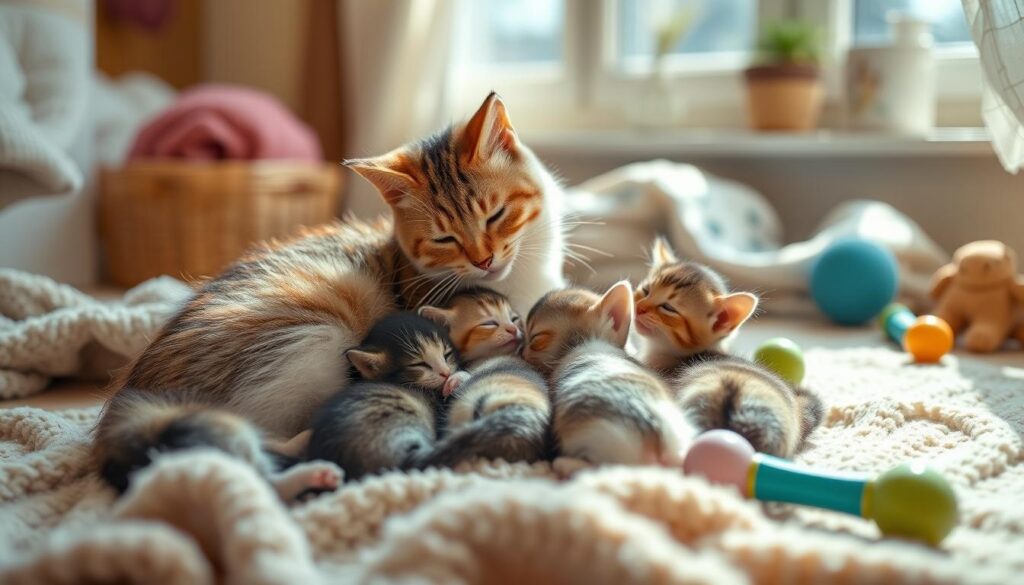
Provide a safe and comfortable environment for your cat to give birth
- Monitor your cat’s behavior and physical changes during labor
- Seek veterinary care if you notice any signs of distress or complications
| Litter Size | Average Number of Kittens |
|---|---|
| Small | 1-3 kittens |
| Medium | 4-6 kittens |
| Large | 7-10 kittens |
Common Complications in Large Litters
As a cat owner, knowing about large litter complications is key. These issues can affect the health of both the mother and kittens. It’s important to watch their health closely.
Look out for risk factors like litter size, mother’s age and health, and any medical conditions. If you see signs of trouble, get veterinarian care right away.
Here are some complications to watch for:
- Difficulty during delivery
- Low birth weight or stillborn kittens
- Infections or other health issues in the mother or kittens
It’s wise to consult a vet if you’re worried about your cat’s pregnancy or her kittens’ health. Knowing about large litter complications and taking action can help ensure a healthy outcome for all.
| Potential Complication | Description |
|---|---|
| Difficulty during delivery | Kittens may become stuck or have difficulty passing through the birth canal |
| Low birth weight or stillborn kittens | Kittens may be born underweight or stillborn due to various factors such as poor nutrition or health issues in the mother |
| Infections or other health issues | Mother or kittens may be at risk of infection or other health issues, such as feline infectious peritonitis (FIP) |
Supporting Your Cat During Pregnancy
As a responsible cat owner, it’s key to give your cat the right cat pregnancy support. Make sure her dietary requirements are met, as she needs more nutrients. A balanced diet is vital for a healthy pregnancy.
To help your cat, focus on environmental preparations. Create a safe, warm, and clean spot for her to have her kittens. This area should be quiet and comfortable.
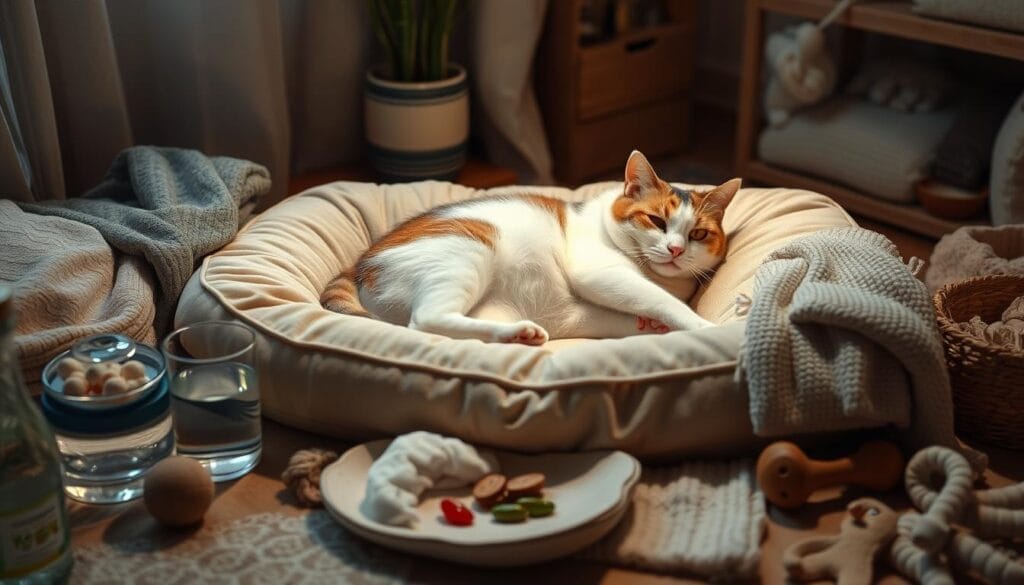
For dietary requirements, increase your cat’s meals to meet her needs. Also, make sure she always has fresh water. With proper cat pregnancy support and environmental preparations, you can help her have a healthy pregnancy and a successful birth.
Here are some tips to support your cat during pregnancy:
- Provide a balanced and nutritious diet that meets your cat’s increased nutritional needs
- Ensure your cat has access to fresh water at all times
- Create a safe and comfortable space for your cat to give birth and care for her kittens
The Impact of Spaying on Cat Health
As a cat owner, you are key to your cat’s health. Spaying is a big decision that helps a lot. It controls the population and boosts your cat’s health.
Spaying cuts down on health risks like uterine infections and breast cancer. It’s a smart move for your cat’s health.
Spaying greatly lowers the risk of mammary and uterine cancer. Cats spayed early have less than a 0.5% chance of breast cancer. It also stops ovarian and uterine cancers in females and prevents a deadly uterine infection called pyometra.
- Reduced risk of certain health problems
- Population control
- Elimination of the risk of uterine infections
- Prevention of breast cancer
Spaying is very safe today, thanks to modern medicine. The chance of serious problems is very low.
When thinking about spaying your cat, remember it’s a big decision. It depends on your cat’s needs and your situation. But with the right info, you can choose what’s best for your cat and help control the population.
Responsible Breeding Practices
As a cat owner, it’s key to know about responsible breeding. This means picking the right time to breed and following expert advice. It also means putting the health and happiness of cats first. This way, we can lower the chance of cats getting sick because of their genes.
Choosing the right time to breed is very important. You should think about the cat’s age, breed, food, and health. For example, younger or older cats might have smaller litters. Cats between 3-4 years old usually have bigger litters. By being careful and following expert advice, you can keep your cats healthy.
Some important things to think about for responsible breeding are:
- Genetic diversity: This helps lower the chance of cats getting sick because of their genes.
- Health checks: Regular checks can spot any health problems early.
- Nutrition: A good diet is key to keeping cats healthy and happy.
By focusing on responsible breeding, you help keep your cats healthy. You also support a good and lasting way of breeding cats.
| Factor | Importance |
|---|---|
| Genetic diversity | High |
| Health checks | High |
| Nutrition | Medium |
Conclusion: Making Informed Decisions About Cat Breeding
Responsible cat breeding needs careful thought and planning. Knowing about litter size, pregnancy issues, and spaying is key. This helps you make choices that keep your cats healthy and happy.
Being a responsible pet owner means more than just breeding. It’s about giving your cats the best life possible. This includes caring for them every step of the way.
Deciding to breed your cat is a big decision. Talk to your vet, look into good breeding practices, and think about the pet overpopulation problem. Making smart choices helps the cat breeding community and ensures a better future for cats everywhere.
FAQ about how many kittens cats can have
How many kittens can a cat have in one litter?
The average number of kittens in a cat’s litter is between 3 to 5, though it can vary. Some cats have litters of as few as one kitten or as many as 8-10. The number depends on factors like the cat’s age, health, breed, and whether it’s her first litter.
Can a cat have multiple litters per year?
Yes, cats can have multiple litters per year. Female cats are known to be polyestrous, meaning they can go into heat several times a year. A healthy adult cat can have up to three litters annually, though it’s recommended to limit this to prevent health complications.
At what age can a cat have kittens?
Cats can become pregnant as early as 4 to 6 months old, although it’s healthier for them to wait until they are at least one year old to have kittens. Breeding too early can lead to health problems for both the mother and the kittens.
How long is a cat’s pregnancy?
A cat’s pregnancy, also called a gestation period, lasts about 63-65 days, or roughly 9 weeks. The exact duration can vary slightly depending on the cat and the number of kittens in the litter.
Does the breed of cat affect the number of kittens?
Yes, some breeds of cats tend to have larger litters than others. For example, larger breeds like Maine Coons can have bigger litters, while smaller breeds may have fewer kittens. However, genetics and the cat’s health play a significant role in litter size as well.
Source Links
- How Many Kittens Can a Cat Have? Vet Verified Facts & FAQ – Catster – https://www.catster.com/cat-health-care/how-many-kittens-can-a-cat-have/
- How Many Cats Are In A Litter Of Kittens? – https://www.dutch.com/blogs/cats/how-many-is-litter-of-kittens?srsltid=AfmBOorGN_bC0VakESp-D8okGbuutG1pMbKtjawoPvbAlWZQUtM0jXYN
- How Many Kittens Can Cats Have? – https://www.petmd.com/cat/general-health/how-many-kittens-can-cats-have
- Cat Reproduction: Heat Cycles, Pregnancies, and More | Bond Vet – https://bondvet.com/b/cat-reproduction
- How Many Kittens Do Cats Have? – https://basepaws.com/cat-insider/how-many-kittens-can-a-cat-have?srsltid=AfmBOor89SjGmwqHmnVuk8hUQdlSkMQjAKU929WnKaKdpLClhigjMfnX
- How Many Kittens is Normal for a First Litter? – https://wagwalking.com/wellness/how-many-kittens-is-normal-for-a-first-litter
- How Many Kittens Can a Cat Have? Cat Litter Sizes – https://www.largehope.com/cat-fostering/how-many-kittens-can-my-cat-have/
- How Many Kittens Can A Cat Have? – https://www.trustedhousesitters.com/blog/pets/how-many-kittens-can-a-cat-have/
- How Many Litters Can a Cat Birth in One Year? – https://www.thesprucepets.com/how-many-pregnancies-per-year-554845
- Did you know? What is Kitten Season. – https://lynchburghumane.org/did-you-know-kitten-season/
- How Many Kittens Can A Cat Have Per Litter And Over A Lifetime? – https://www.catological.com/how-many-kittens-litter-lifetime/
- How Many Kittens Do Cats Have? – https://basepaws.com/cat-insider/how-many-kittens-can-a-cat-have?srsltid=AfmBOop0P4GIFixnJE1tW_gJQCq5Bx3xBLsnSdl52t6Idf4hBG8N5iwq
- How Many Kittens Do Cats Have? – https://basepaws.com/cat-insider/how-many-kittens-can-a-cat-have?srsltid=AfmBOoo-qgS0_EThL_onyQKK_s1kh2Gro-BtcjjHm9Ofd9DRU4lML5C6
- How Many Cats Are In A Litter Of Kittens? – https://www.dutch.com/blogs/cats/how-many-is-litter-of-kittens?srsltid=AfmBOoosqokGJmBKh3NMEKdnSFjN16R10mPN1L9S7h5HwhngPrUxb3R9
- How Many Kittens Can A Cat Have? – https://catcaveco.com/blogs/main/how-many-kitens-can-a-cat-have?srsltid=AfmBOor9IdG_Fk5jXphMzGsOsk-cC5WlU1wAGGe35Sva5uC73PCJclKj
- How Many Kittens Do Cats Have? – https://basepaws.com/cat-insider/how-many-kittens-can-a-cat-have?srsltid=AfmBOoow4Kw3E7uRS2JL8sckPakXqZhEuXz4NwxPdB_0FvRjxrDbk-h6
- Cat Pregnancy: Signs, Stages and Care – https://www.petmd.com/cat/conditions/reproductive/cat-pregnancy-and-kittens-complete-guide
- Pregnancy and Parturition in Cats | VCA Animal Hospitals – https://vcahospitals.com/know-your-pet/pregnancy-and-parturition-in-cats
- PDF – https://www.cats.org.uk/media/1029/eg18_pregnant_cats-_birth_and_care_of_young_kittens.pdf
- Spaying a Cat: Everything You Need to Know – https://www.smalldoorvet.com/learning-center/medical/spaying-cats-everything-you-need-to-know
- Spaying in Cats | VCA Animal Hospitals – https://vcahospitals.com/know-your-pet/spaying-in-cats
- How Many Kittens Can A Cat Have? – https://petozy.com/blogs/about-cats/how-many-kittens-can-a-cat-have
- How Many Kittens Are in a Litter? Vet-Reviewed Health Facts – Catster – https://www.catster.com/cat-health-care/how-many-kittens-are-in-a-litter/
- PDF – https://food.ec.europa.eu/system/files/2020-11/aw_platform_plat-conc_guide_cat-breeding.pdf




